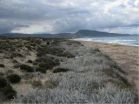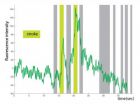(Press-News.org) Jan. 30 2013 - Scientists have long known that cattle produce carbon dioxide and methane throughout their lives, but a new study pinpoints the cow-calf stage as a major contributor of greenhouse gases during beef production.
In a new paper for the Journal of Animal Science, scientists estimate greenhouse gas emissions from beef cattle during different stages of life. They show that, depending on which production system farmers used, beef production has a carbon footprint ranging from 10.7 to 22.6 kg of carbon dioxide equivalent per kg of hot carcass weight.
According to study co-author Frank Mitloehner, an associate professor in the Department of Animal Science at UC Davis, one source of greenhouse gases was surprising.
"If you look at everything that contributes to greenhouse gases through the beef supply chain, then it is the cow-calf that produces the greatest greenhouse gases," Mitloehner said.
In the cow-calf phase, the cow gives birth and nurses the calf until the calf is six to 10 months old. During this time, the cow eats rough plants like hay and grasses. The methane-producing bacteria in the cow's gut thrive on these plants.
"The more roughage is in the diet of the ruminant animal, the more methane is produced by the microbes in the gut of the ruminant, and methane comes out the front end," Mitloehner said.
In feedlots, by contrast, cattle eat mostly corn and grains, which the methane-producing bacteria cannot use as effectively.
Methane is one of the most important greenhouse gases. Methane has a greater capacity to trap heat in the atmosphere than carbon dioxide.
The beef industry has been paying close attention to greenhouse gas emissions in recent years.
"We are doing a lot to measure and mitigate our impact," said Chase Adams, director of communications for the National Cattlemen's Beef Association.
In a 2011 paper for the Journal of Animal Science, researcher Jude Capper showed that the beef industry today uses significantly less water and land than 30 years ago. The industry has also reduced its carbon footprint by 16.3 percent per billion kilograms of beef produced.
According to Mitloehner, beef producers can further reduce their carbon impact by using new technologies like growth promotants. However, consumers are often uncomfortable with these methods, and they choose organic beef or beef with reduced amounts of growth promotants.
"The technologies many consumers are critical of are those that help us receive the greatest environmental gains," Mitloehner said.
###The study by Mitloehner and his colleagues is titled "Carbon footprint and ammonia emissions of California beef production systems." It can be read in full at journalofanimalscience.org.
Media contact:
Amy Stewart
American Society of Animal Science
amystewart@ucdavis.edu
In beef production, cow-calf phase contributes most greenhouse gases
Data could help farmers reduce emissions
2013-01-31
ELSE PRESS RELEASES FROM THIS DATE:
Confirmed: How plant communities endure stress
2013-01-31
PROVIDENCE, R.I. [Brown University] — Ecology is rife with predation, competition, and other dramatic "negative interactions," but those alone do not determine the course life on Earth. Organisms sometimes benefit each other, too, and according to the Stress Gradient Hypothesis, their "positive interactions" become measurably more influential when ecosystems become threatened by conditions such as drought. Ecologists have argued about the hypothesis ever since Brown University ecologist Mark Bertness co-proposed it in 1994; Bertness says a large new global meta-analysis ...
Peer pressure trumps 'thin' ideals in the media
2013-01-31
Peers exert a greater influence on teenage girls' dissatisfaction with their bodies than do thin ideals in television or social media use, according to new research¹ by Dr. Christopher J. Ferguson and colleagues from Texas A&M International University in the U.S. Their study is published online in Springer's Journal of Youth and Adolescence.
The influence of the media on body image, life satisfaction, and symptoms of eating disorders in teenage girls is a hot debate. Some experts believe that media influences on body dissatisfaction may extend to symptoms of eating disorders. ...
Lake Mead aquatic-science research documents substantial improvements in ecosystem
2013-01-31
LAS VEGAS, Nev. — Lake Mead National Recreation Area's water quality is good, the sport fish populations are sufficient, and the lakes provide important habitat for an increasing number of birds. This positive trend is documented in a new report published today that leads to a better understanding of the natural resources of Lake Mead and Lake Mohave, and the issues that may affect natural resource management of Lake Mead NRA.
"While the Lake Mead ecosystem is generally healthy and robust, the minor problems documented in the report are all being addressed by the appropriate ...
Discovery of sexual mating in Candida albicans could provide insights into infections
2013-01-31
Like many fungi and one-celled organisms, Candida albicans, a normally harmless microbe that can turn deadly, has long been thought to reproduce without sexual mating. But a new study by Professor Judith Berman and colleagues at the University of Minnesota and Tel Aviv University shows that C. albicans is capable of sexual reproduction.
The finding, published online by Nature January 30, represents an important breakthrough in understanding how this pathogen has been shaped by evolution, which could suggest strategies for preventing and treating the often serious infections ...
Are gender and ethnicity risk factors for metabolic syndrome in children?
2013-01-31
New Rochelle, NY, January 30, 2013—Metabolic syndrome is more likely to affect children who are obese than overweight or non-overweight and who have other characteristics associated with the disorder, such as high blood pressure or insulin resistance. A new comprehensive and systematic review of the medical literature on metabolic syndrome in children that probed deeper to evaluate the risk associated with gender, ethnicity, and geography was published in Metabolic Syndrome and Related Disorders, a peer-reviewed journal from Mary Ann Liebert, Inc., publishers. The article ...
Silibinin, found in milk thistle, protects against UV-induced skin cancer
2013-01-31
A pair of University of Colorado Cancer Center studies published this month show that the milk thistle extract, silibinin, kills skin cells mutated by UVA radiation and protects against damage by UVB radiation – thus protecting against UV-induced skin cancer and photo-aging.
"When you have a cell affected by UV radiation, you either want to repair it or kill it so that it cannot go on to cause cancer. We show that silibinin does both," says Rajesh Agarwal, PhD, co-program leader of Cancer Prevention and Control at the CU Cancer Center and professor at the Skaggs School ...
Prostate cancer study tracks long-term urinary, sexual and bowel function side effects
2013-01-31
A new study comparing outcomes among prostate cancer patients treated with surgery versus radiotherapy found differences in urinary, bowel and sexual function after short-term follow-up, but those differences were no longer significant 15 years after initial treatment.
The study, led by first author Matthew Resnick, M.D., instructor in Urologic Surgery, Vanderbilt University Medical Center, was published in the Jan. 31 issue of the New England Journal of Medicine.
From Oct. 1, 1994, through Oct. 31, 1995, investigators enrolled men who had been diagnosed with localized ...
Checking out open access
2013-01-31
This press release is available in French.
Montreal, January 20, 2013 – From Wikipedia to shareware, the Internet has made information and software more widely available than ever. At the heart of this explosion is the simple idea that information should be open and free for anyone. Yet with publishers charging exorbitant fees for subscriptions to academic journals, university libraries are struggling to keep up.
Writing in the Journal of Academic Librarianship, Concordia collections librarian Geoffrey Little says that a key way to meet that challenge is through ...
Sorting out stroking sensations
2013-01-31
PASADENA, Calif.—The skin is a human being's largest sensory organ, helping to distinguish between a pleasant contact, like a caress, and a negative sensation, like a pinch or a burn. Previous studies have shown that these sensations are carried to the brain by different types of sensory neurons that have nerve endings in the skin. Only a few of those neuron types have been identified, however, and most of those detect painful stimuli. Now biologists at the California Institute of Technology (Caltech) have identified in mice a specific class of skin sensory neurons that ...
Rejuvenation of the Southern Appalachians
2013-01-31
Boulder, Colorado, USA – In the February 2013 issue of GSA Today, Sean Gallen and his colleagues from the Department of Marine, Earth, and Atmospheric Sciences at North Carolina State University take a new look at the origin of the Miocene rejuvenation of topographic relief in the southern Appalachians.
Conventional wisdom holds that the southern Appalachian Mountains have not experienced a significant phase of tectonic forcing for more than 200 million years; yet, they share many characteristics with tectonically active settings, including locally high topographic relief, ...
LAST 30 PRESS RELEASES:
University of Oklahoma researcher awarded funding to pursue AI-powered material design
Exploring how the visual system recovers following injury
Support for parents with infants at pediatric check-ups leads to better reading and math skills in elementary school
Kids’ behavioral health is a growing share of family health costs
Day & night: Cancer disrupts the brain’s natural rhythm
COVID-19 vaccination significantly reduces risk to pregnant women and baby
The role of vaccination in maternal and perinatal outcomes associated with COVID-19 in pregnancy
Mayo Clinic smartwatch system helps parents shorten and defuse children's severe tantrums early
Behavioral health spending spikes to 40% of all children’s health expenditures, nearly doubling in a decade
Digital cognitive behavioral treatment for generalized anxiety disorder
Expenditures for pediatric behavioral health care over time and estimated family financial burden
Air conditioning in nursing homes and mortality during extreme heat
The Alps to lose a record number of glaciers in the next decade
What makes a good proton conductor?
New science reporting guide published for journalists in Bulgaria
New international study reveals major survival gaps among children with cancer
New science reporting guide published for journalists in Turkey
Scientists develop a smarter mRNA therapy that knows which cells to target
Neuroanatomy-informed brain–machine hybrid intelligence for robust acoustic target detection
Eight SwRI hydrogen projects funded by ENERGYWERX
The Lundquist Institute and its start-up company Vitalex Biosciences Announces Strategic Advancement of Second-Generation fungal Vaccine VXV-01 through Phase 1 Trials under $40 Million Competitive Con
Fine particles in pollution are associated with early signs of autoimmune disease
Review article | Towards a Global Ground-Based Earth Observatory (GGBEO): Leveraging existing systems and networks
Penn and UMich create world’s smallest programmable, autonomous robots
Cleveland researchers launch first major study to address ‘hidden performance killer’ in athletes
To connect across politics, try saying what you oppose
Modulating key interaction prevents virus from entering cells
Project explores barriers to NHS career progression facing international medical graduates
Jeonbuk National University researchers explore the impact of different seasonings on the flavor perception of Doenjang soup
Two Keck Medicine of USC Hospitals named Leapfrog Top Teaching Hospitals
[Press-News.org] In beef production, cow-calf phase contributes most greenhouse gasesData could help farmers reduce emissions



